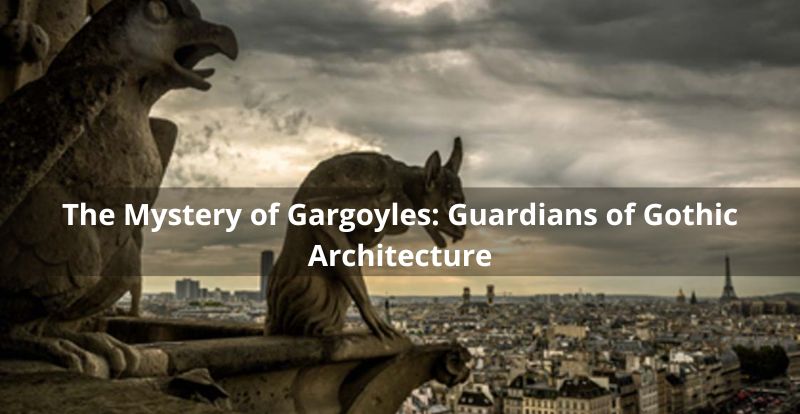The Mystery of Gargoyles: Guardians of Gothic Architecture
The Mystery of Gargoyles: Guardians of Gothic Architecture. Gargoyles stand as mysterious sentinels in the realm of architecture and mythology, captivating humanity for centuries with their imposing presence and enigmatic symbolism. In this extensive exploration, we delve into the history, curiosities, and comparative mythology of gargoyles, unraveling their role as protective guardians and their enduring connection to contemporary culture.
It may interest you: Exploring Europe's Largest Gothic Castle: Malbork Castle in Poland
Video: Gargoyles and Grotesques of the Southern French Gothic Architecture - The Dark Side of Medieval Art

Unveiling the Enigmatic World of Gargoyles
Etymology of Gargoyle: Unraveling the Origins
The term "gargoyle" traces its roots back to the ancient Greek and Latin languages, with origins in words like "gargouille" in Old French, meaning "gargle," and "gurgulio" in Latin. These etymological roots hint at the primary function of gargoyles: as water spouts to drain rainwater away from buildings, thus safeguarding their structural integrity.
The History and Origins of Gargoyles: An Intriguing Journey
Gargoyles boast a captivating history that stretches back to antiquity. Originating in the architecture and mythology of ancient civilizations such as Mesopotamia and Egypt, these grotesque sculptures adorned temples and palaces, serving both decorative and symbolic purposes. However, it was during the Romanesque and Gothic periods that gargoyles reached the pinnacle of their development and popularity.
The Emergence of Gargoyles in Gothic Architecture: Guardians of the Heights
During the Gothic era, which flourished from the 12th century onward, gargoyles took on their iconic form and their protective function intensified. As cathedrals and churches soared skyward, gargoyles became imposing guardians, watching over sacred spaces from lofty perches. Beyond their practical role as water drainage mechanisms, these stone creatures were believed to ward off malevolent forces, safeguarding sacred spaces from evil influences.
The Artistry and Diversity of Gargoyles: A Testament to Creativity
Over the centuries, the skillful craftsmanship of Gothic artisans breathed life into a myriad of unique gargoyles. Ranging from grotesque creatures to human and fantastical animal figures, each gargoyle possessed its own personality and appearance. Some even depicted biblical scenes or historical events, adding layers of narrative complexity to architectural designs.
Curiosities and Characteristics of Gargoyles: Guardians in Stone
Known for their grotesque and fantastical appearance, gargoyles served primarily as conduits for diverting water from structures in Gothic architecture. Yet, their significance transcended mere practicality, symbolizing protection against malevolent forces and evil spirits. Perched high on cathedrals, churches, and other ancient buildings, they stood as silent sentinels, vigilant and protective.
Comparative Mythology of Gargoyles: Echoes Across Cultures
Gargoyles feature prominently in various mythologies and legends worldwide. From ancient Greece and Celtic traditions to Japanese folklore, echoes of these stone guardians resonate across diverse cultures. In Greek mythology, creatures akin to gargoyles, known as chimeras, were believed to be hybrids of lion, goat, and serpent, serving as guardians of sacred spaces.
The Enduring Legacy of Gargoyles: From Medieval Marvels to Modern Inspirations
Though their prevalence waned in modern architecture, the legacy of gargoyles endures. Many contemporary buildings still incorporate gargoyles for their aesthetic value and historical resonance. While no longer essential for water drainage, these iconic sculptures remain a popular choice for embellishing structures, evoking the nostalgia of medieval architecture.
Gargoyles in Popular Culture: From Myth to Modernity
Throughout history, gargoyles have ignited the imagination and appeared in various forms of art, literature, and popular culture. They have served as inspiration for sculptures, illustrations, films, and novels, becoming iconic symbols of medieval architecture. In contemporary culture, gargoyles are often portrayed as mystical and powerful creatures, possessing supernatural abilities and protective powers.
Gargoyles: Guardians of the Silver Screen
Gargoyles have made numerous appearances in film and television, captivating audiences with their eerie charm and formidable presence. They have been featured in horror movies, fantasy epics, and animated series, where they often play roles as guardians, protectors, or antagonists. Their iconic silhouette against the backdrop of ancient buildings adds an air of mystery and intrigue to cinematic landscapes.
Gargoyles in Literature: Tales of Myth and Magic
In literature, gargoyles have been the subject of countless stories, poems, and novels, each weaving its own tapestry of myth and magic around these enigmatic creatures. Authors have explored the symbolism and lore surrounding gargoyles, delving into their origins, powers, and interactions with humans. From Gothic novels to modern fantasy literature, gargoyles continue to fascinate and enthrall readers with their timeless appeal.
Gargoyles in Contemporary Art: Sculptures of Stone and Imagination
In the world of art, gargoyles remain a popular subject for sculptors and visual artists, who seek to capture their intricate details and imposing presence in various mediums. From traditional stone carvings to modern interpretations in metal and clay, artists continue to explore the aesthetic and symbolic potential of gargoyles. Their enduring popularity in contemporary art reflects their status as enduring symbols of mystery and majesty.
Gargoyles in Pop Culture: Merchandise and Memorabilia
Gargoyles have also permeated popular culture through merchandise and memorabilia, ranging from figurines and collectibles to clothing and accessories. Their distinctive appearance and rich symbolism make them popular choices for merchandise aimed at fans of fantasy, Gothic, and supernatural themes. Whether adorning t-shirts, posters, or home decor, gargoyles continue to leave their mark on pop culture.
gargoyles stand as enduring symbols of mystery and majesty, embodying centuries of history and mythology. From their practical function as architectural features to their symbolic role as protectors against evil, gargoyles have left an indelible mark on human culture and imagination. Though their heyday may have passed, their legacy continues to captivate and inspire generations worldwide.
Si quieres conocer otros artículos parecidos a The Mystery of Gargoyles: Guardians of Gothic Architecture puedes visitar la categoría Gothic.

Leave a Reply